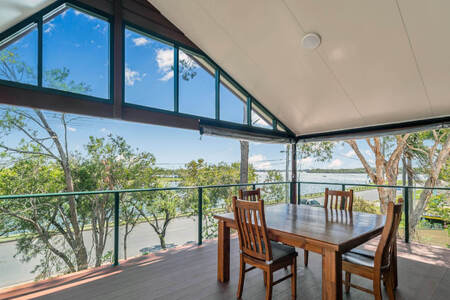
How to Extend Your Existing Deck?
Are you looking for innovative ways to extend your existing deck? We provide tips on how to build an affordable and easy deck extension. Read on to learn more!
Read Full Story
Floods can cause catastrophic damage to homes and properties. Flood waters penetrate exterior walls, seep into interior walls, compromise concrete slabs, and lead to widespread destruction.
Homes in flood-prone areas or high flood-risk zones face a constant threat of water damage. Floodproofing is essential to reinforce homes against the pressures of flood damage and flood waters. This article will provide tips for minimising flood damage, inspecting for compromises after flooding, and reinforcing home foundations and structures.
We will overview how flooding impacts key structural components like walls and slabs, guide floodproofing measures, what to do during a flood event, and post-flood damage control. With insight from flood maps and experienced Sydney builders, homeowners can better understand flood risk and proactively protect their properties when the flood waters rise.
Flooding can cause significant damage to home foundations and structures if they are not reinforced and floodproofed. Excess water penetrates the building envelope when flood waters rise above the expected flood level. This can impact electrical systems, sump pumps, HVAC equipment, service equipment, and other vulnerable components.
Foundations bear the brunt of flood damage. Concrete slabs and crawlspaces absorb moisture, compromising structural integrity. Excess hydrostatic pressure can dislodge walls, cause cracks, and alter load-bearing capacities. Waterlogged materials like wood can warp and deteriorate.

If flood waters recede before structural damage occurs, effects may be minimal. But extensive flooding puts tremendous strain on foundations. It creates both immediate and long-term safety risks as compromised foundations become unstable.
Homeowners in flood-prone areas must proactively reinforce foundations and flood-proof vulnerable equipment. Understanding how flooding impacts structures is the first step toward
preventing severe flood damage.
Reinforcing your home against potential flood waters is an effective preventative measure. Both wet and dry floodproofing techniques can mitigate safety risks and damage.
Wet floodproofing allows flood water to enter the structure in a controlled, minimised way. This might involve relocating electrical systems and installing flood vents. Consult with your local
authority before constructing barriers around your home.
Dry floodproofing seals the exterior to prevent water intrusion. This requires specialised products like flood shields, sealants and waterproof coatings. Hire a licensed plumber to install backflow valves and sump pumps to control water flow.
Identify entry points where flood waters could penetrate the structure. Seal cracks, close openings, and reinforce walls and doors. Install permanent barriers around the HVAC and critical systems. Raise utilities and equipment above expected flood levels.
Implementing floodproofing measures takes extensive planning and preparation. However, this upfront investment will minimise dangers and damage when flooding occurs. A floodproof home provides peace of mind for owners in high-risk flood zones.
When flood waters are imminent, minimise water damage and protect your property. Safety should be the top priority during a flood event. Sandbag around the foundation and other vulnerable areas of your house or building. This can help divert water away from the structure. Focus on reinforcing entry points identified during floodproofing.
Remove valuable items and furniture from lower levels that could get wet. Relocate essential documents, appliances, and possessions to the upper floors. Turn off electricity to areas at risk of water exposure.
Prevent contamination by shutting off gas lines and propane tanks. Back up critical files and data in case of computer or technology damage. Limit movement on upper levels of the structure during flooding. The added weight and activity can further compromise the foundation. Wait for flood waters to fully recede before inspecting for damage.
Have an emergency plan in place to evacuate if necessary. Work with local authorities to stay informed about flood warnings and water levels. Take all effective measures to minimise property and foundation damage until flooding subsides.

After flood waters recede, safely re-enter your property to assess damage. Look for compromised walls, floors, foundations, and landscaping. Flood exposure can cause long-term issues if not addressed.
Remove standing water by opening drains and pumping out basements or crawlspaces. This prevents further foundation damage. Dry out the building slowly to avoid mould growth. Running dehumidifiers can accelerate drying. Treat or remove soaked carpets, drywall, insulation, and panelling. Disinfect and clean all surfaces that were exposed to flood waters. Look for cracks or failures in the foundation, distorted frames, and lingering moisture.

Hire a structural engineer to inspect your home’s foundation for soundness. They can identify underlying issues and ensure stability. Repair any damage like cracks before it worsens. Monitor wood floors and furniture for warping as they dry out. Ventilate the space well during cleanup. Check that electrical, plumbing, and gas systems are intact before turning them back on.
Take every effective measure during clean-up and repairs. Following floods, dangers still lurk within damaged buildings and on compromised lands. Stay alert and get professional help to ensure your home’s safety. Thorough flood damage control is recommended before occupying the structure again.
It may be tempting to downplay flood damage or delay repairs. But this poses serious short and long-term safety risks that worsen over time.
Standing water weakens foundations and compromises structural integrity. Contaminants seep into walls and materials, causing deterioration and mould growth. Warped or cracked sections become unstable.
If left unchecked, weakened areas can fail suddenly and cause collapses. This puts occupants in danger if the structure shifts or falls. Damage also allows moisture and pests to infiltrate,
creating unhealthy conditions. Gaps in the building envelope due to floods make it vulnerable to future weather events. The property remains at risk without proper reinforcement, floodproofing, and drainage control.
If not thoroughly dried and repaired after flooding, electrical, plumbing, and gas systems are prone to short circuits and fires. Using the building without adequate restoration greatly elevates
fire risk. Only comprehensive inspection and repair by a structural engineer and licensed contractors can confirm the property’s safety. Attempting DIY flood damage control is extremely dangerous, and professional intervention is highly recommended. Don’t let the problem fester - the safety risks only escalate over time.

If your home suffers severe flood damage, get help from professional builders to properly inspect and repair your foundation. At Final Touch Carpentry & Construction, our experienced team specialises in flood damage repair and control throughout Sydney.
We understand the intricacies of foundation damage and can pinpoint underlying structural issues. Our licensed builders will advise on the best remediation methods to stabilise and reinforce your home’s foundation. We use advanced techniques to floodproof your property against future risks permanently.
We can restore your home quickly and safely with pragmatic solutions tailored to your unique needs. Don’t let unaddressed flood damage turn into long-term safety hazards. Call the experts at Final Touch Carpentry & Construction in Sydney today at (02) 8605 1901 for superior flood damage repair. Or request a quote online to get started securing your home’s foundation.
Are you looking for innovative ways to extend your existing deck? We provide tips on how to build an affordable and easy deck extension. Read on to learn more!
Read Full StoryLooking for an easy way to oil a timber deck? Take a look at our detailed guide on re-oiling your old timber deck to make it look like new again.
Read Full StoryLooking for ways to protect your decking from termite colonies? We’ve got you covered with our guide. Final Touch cover everything you need to know about termites and your timber deck.
Read Full Story

